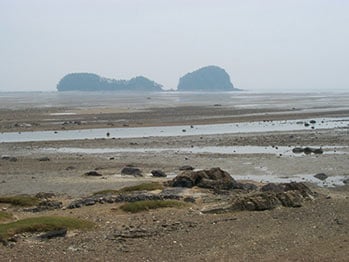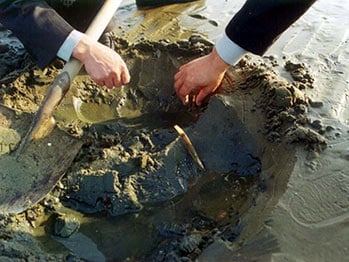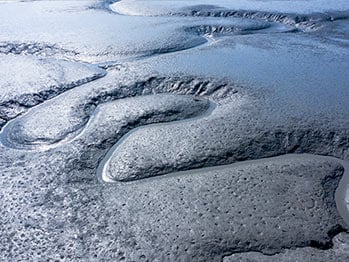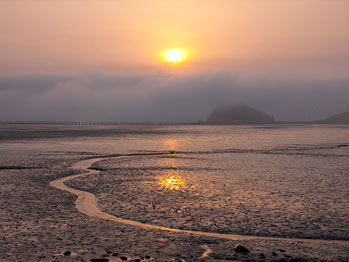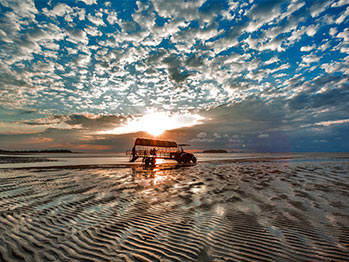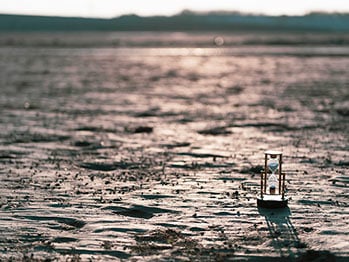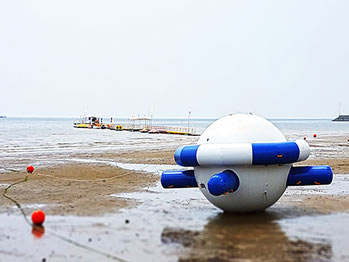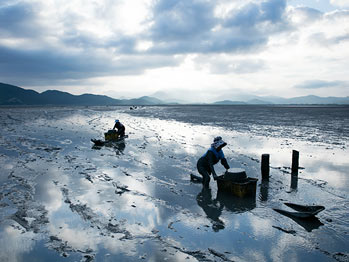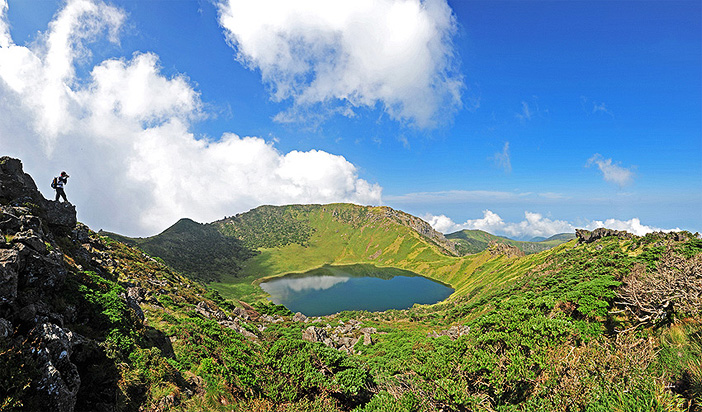 【 Photo: Baengnokdam Crater Lake on Hallasan Mountain 】
【 Photo: Baengnokdam Crater Lake on Hallasan Mountain 】 Jeju Volcanic Island and Lava Tubes (Designated 2007)
Location
- Seongsan-eup & Gujwa-eup areas, Jeju Island
Jeju Island was formed through volcanic activity over 1.8 million years ago. As such, the island is a valuable asset in research of geological features and topography of volcanic landforms such as volcanic cones and lava tubes. Jeju’s lava tubes are known to be among the most beautiful lava tubes in the world, featuring dark walls and various colors of carbonation on the ceilings and ground. Among the many natural formations, Hallasan National Park, Seongsan Ilchulbong Tuff Cone, and the Geomunoreum Volcanic Cone lava tube system have jointly been designated as a World Natural Heritage Site by UNESCO.
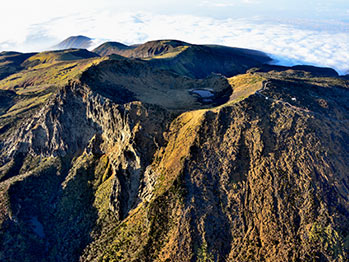 【 Photo: Hallasan Mountain 】
【 Photo: Hallasan Mountain 】 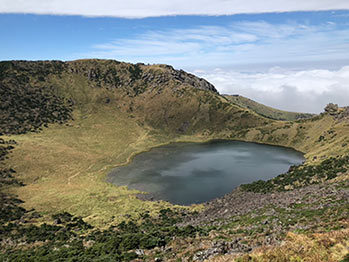 【 Photo: Baengnokdam Crater Lake 】
【 Photo: Baengnokdam Crater Lake 】
Reaching to a height of 1,947 meters, Hallasan Mountain is the tallest mountain in Korea with gentle slopes formed by eons of volcanic activity. There are around 384 parasitic volcanoes which formed in the surrounding area. A variety of rare plants inhabit the slopes, including the Korean fir trees (Abies Koreana) that are native to Korea.
In addition, the top of Hallasan Mountain offers a view of the magnificent vista over the entire Jeju Island. The peak also holds Baengnokdam, a vast crater lake that is both beautiful and highly valued in academic research.
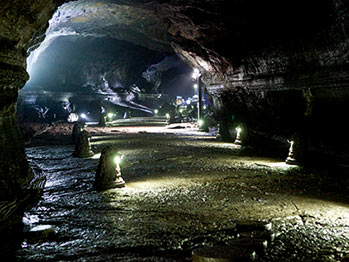 【 Photo: Manjanggul Lava Tube 】
【 Photo: Manjanggul Lava Tube 】 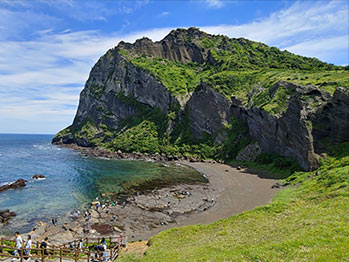 【 Photo: Seongsan Ilchulbong Tuff Cone 】
【 Photo: Seongsan Ilchulbong Tuff Cone 】
In the Geomunoreum Volcanic Cone region, there are lava tubes of various sizes formed by basalt lava spewed from Geomunoreum Volcanic Cone that flowed to the ocean. The most famous of these lava tubes are Gimnyeonggul Lava Tube, Dangcheomuldonggul Lava Tube, Manjanggul Lava Tube, Bengdwigul Lava Tube, and Yongcheondonggul Lava Tube.
Manjanggul Lava Tube features a variety of stalactites and stalagmites, along with a bridge and waterfall formed by lava. The cave and its various formations have outstanding research value in understanding the formation and characteristics of lava tubes.
Seongsan Ilchulbong Tuff Cone, one of the many parasitic cones on Jeju Island, was uniquely created on the sea floor. This popular attraction is great for catching the sunrise. The cliffs on the three sides facing the sea were formed by the waves eating away at the lava, while the western side was connected to the main island due to a build-up of sand and gravel.
- Nearby Attractions
Donnaeko Resort
Halla Ecological Forest
Sanbangsan Mountain
Soesokkak River Pool
Seopjikoji
Cheonjiyeonpokpo Falls - Websites:
Jeju World Natural Heritage www.jeju.go.kr/jejuwnh (Korean, English, Japanese, Chinese)
Hallasan National Park www.jeju.go.kr/hallasan (Korean, English, Japanese, Chinese)
Getbol, Korean Tidal Flats (Designated 2021)
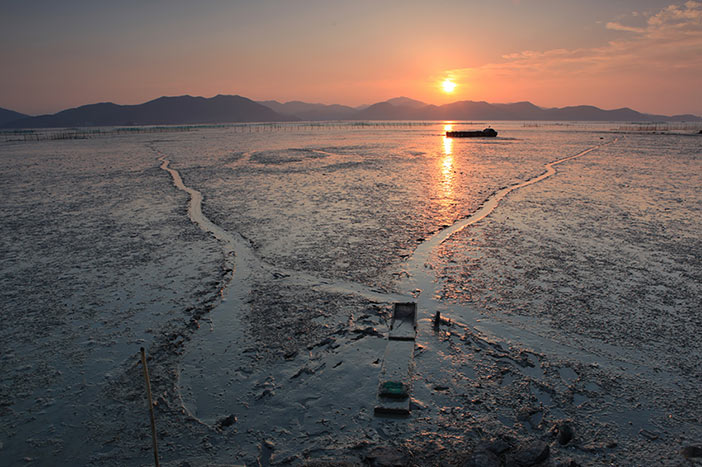 【 Photo: Suncheonman Bay Wetland Reserve 】
【 Photo: Suncheonman Bay Wetland Reserve 】 Locations
- Seocheon Tidal Flat: Yeonan Wetland of Songnim-ri in Seocheon, Chungcheongnam-do
- Shinan Tidal Flat: Jungdo-myeon in Shinan, Jeollanam-do
- Gochang Tidal Flat: Heungdeok-myeon, Buan-myeon, and Simwon-myeon in Gochang, Jeollabuk-do
- Boseong Tidal Flat: Beolgyo-eup in Boseong, Jeollanam-do
- Suncheon Tidal Flat: 513-25 Suncheonman-gil, Suncheon, Jeollanam-do
Korean tidal flats, called getbol (gaetbeol), are home to more than 2,000 living organisms including endangered migratory birds. The tidal flats are an important stopover point for migratory birds from South Asia and Oceania. Four tidals flats - Seocheon, Gochang, Shinan, and Boseong-Suncheon - spread across five city jurisdictons and were designated as a Wetlands Protection Area for showing high levels of biodiversity. These tidal flats were also designated as World Natural Heritage in 2021.
Visitors to Seocheon Tidal Flat can see a rare species of spoon-billed sandpiper. These rare birds are on the IUCN's Red List of Threatened Species. In addition to spoon-billed sandpipers, Seocheon Tidal Flat is also home to 101 types of birds and 95 types of benthos organisms.
One of the largest tidals flats in the world, Shinan Tidal Flat takes up a big part of Korea's tidal flats. Shinan Tidal Flat was formed due to cosistent low and high tides among various nearby islands. The sediment layers in the mudflats that create a phenomenon referred to as sand-gravel string, making the tidal flat unique from other tidal flats around the world. Shinan Tidal Flat Museum, the largest tidal flat education center in Korea, provides detailed information about various living organisms that live in Korea's tidal flats.
Gochang Tidal Flat is special in that it is composed of mud, sand, and a mix of both, making it an ideal location to produce manila clams. Nearby attractions include Mandol Tidal Flats Experience Center and Hajeon Getbol Village.
Boseong-Suncheon Tidal is a result of soft and delicate sand deposits that were collected from the Geumgang River. The flat is home to hooded crane, an endangered species, as well as halophyte colonies. Boseong-Suncheon Tidal Flat is characterized by its large salt marsh and various types of halophytes..
- Websites:
- Seocheon County Office: www.seocheon.go.kr (Korean, English, Japanese, Chinese, Vietnamese, Cambodian)
- Shinan County Office: www.shinan.go.kr (Korean only)
- Gochang County Office: www.gochang.go.kr (Korean, English, Japanese, Chinese)
- Boseong County Office: www.boseong.go.kr/?main=true (Korean, English, Japanese, Chinese)
- Suncheon City Hall: www.suncheon.go.kr(Korean, English, Japanese, Chinese) - 1330 Korea Travel Helpline: +82-2-1330 (Korean, English, Japanese, Chinese, Russian, Vietnamese, Thai, Indonesian)
This page was last updated on December 9, 2024, and therefore information may differ from what is presented here.

